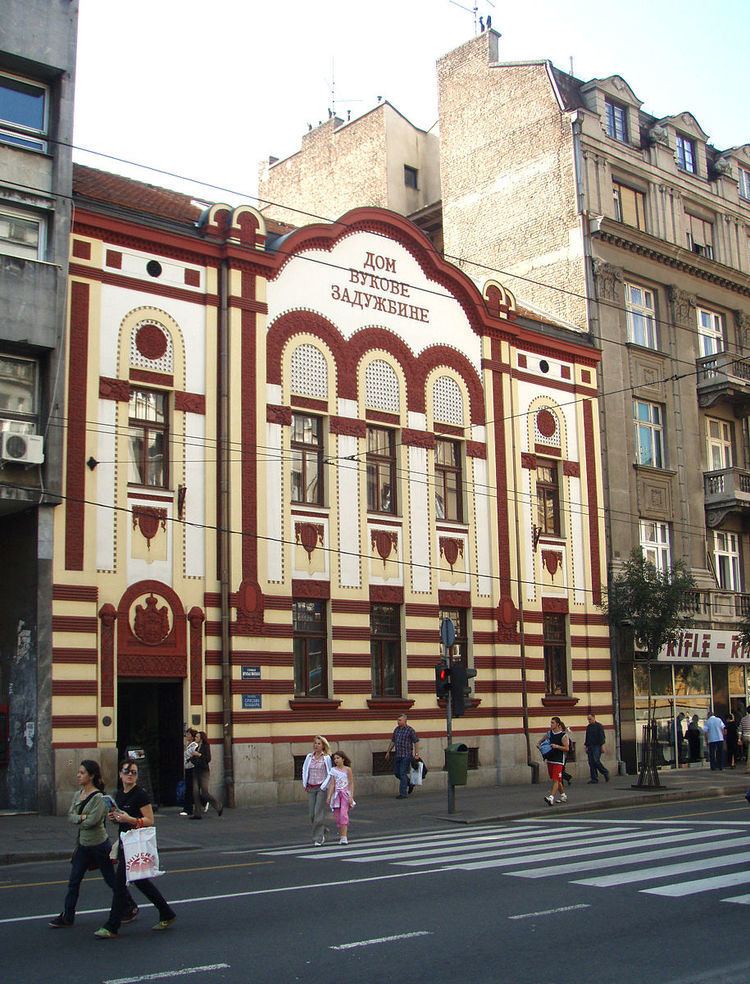Opened 1871 | Architect Aleksandar Bugarski | |
 | ||
Similar Jevrem Grujić's House, Novi dvor, Captain Miša's Mansion, Museum of Vuk and Dositej, Stari dvor | ||
The House of Vuk's Foundation is a building in Belgrade in which the Vuk's Foundation is situated. The building is located on the Теrazije at 2 Kralja Milana Street and is one of the oldest structures in that part of Belgrade, with its construction having been initiated in 1870. Аleksandar Bugarski, one of the most prominent Serbian architects in the 19th century, was the designer for the first two story house, and he also conformed to the style of Academic Art.
Contents
Map of Dom Vukove zadu%C5%BEbine, Kralja Milana 2, Beograd, Serbia
History
The building was built by the judge Dimitrije Mita Golubović. In the beginning, it was the head office of the Russian Imperial Consulate, then the Serbian Institute for war orphans, and, since 1879, the Ministry of Education. Due to the growth of the Ministry there was a need for expansion, which commenced in 1912 towards the Sava slope. The building was also redecorated and the assignment of renovating the building and making it look luxurious was given to an architect Branko Tanazević who was to work on the facade. A painter and decorator Dragutin Inkiostri was put in charge of the interior decoration. The two cooperated on the project, despite being fierce opponents as far as national style was concerned (which was the selected new style for the new facade and the interior).
The expansion of the building reflects the growing jurisdiction of the Ministry of Education over the newly joined territories of the Principality and the Kingdom of Serbia, and the merger of new sections of the Ministry. The smaller courtyard wing was repaired and upgraded in 1906, with the decorative works in the interior done by the painter Dragutin Inkiostri Medenjak, who happened to be the only decorative painter in Belgrade at that time. Within these decorative works, he included a folk ornament motif in accordance with the "national" style.
The growing jurisdiction of the Ministry of Education over the territories of "Macedonia, Kosovo and Old Serbia", which became part of the Kingdom of Serbia after the First Balkan War in 1912, as well as the need for redecoration, led to the upgrading of the courtyard wing and the total reconstruction of the main front facade in the same year. It was done in "Serbian-Byzantine" style according to the design of Branko Tanazević. The last renovation of the building for the Ministry – the new wing towards the Kraljica Natalija Street – was carried out in 1924, designed by architect Žarko Tatić.
From 1879 until 1952, the building was home to the Ministry of Education; from 1880, the Church department of the Ministry of Education of the Principality of Serbia; since 1914, the Foundation Department of the Ministry of Education of the Kingdom of Serbia; and since 1919, it was also the Artistic Department (of the Kingdom of SHS and the Kingdom of Yugoslavia, and after 1944 of the National Republic of Serbia), the same year when the Church Department was separated from the Ministry, in order to form the special Ministry of Religion. Certain departments of the Ministry of Education, despite the expansion, remained outside the main building. During the period of occupation in the First World War, the building was used as the headquarters of the Main Commissariat of Austro-Hungarian Army, and as the Main Postal Administration as well. After the capitulation of the Kingdom of Yugoslavia in 1941, the Ministry of Education was closed for a short time, but the Department for the German language teaching was founded and it worked until October 1944. In November 1944 the Committee for the Education of the NR of Serbia was founded, and tile April 1945 it grew into the Ministry of Education. It remained in the building until 1952, when the Federal Institute for the Patterns and the Federal Institute for Work Productivity moved into space vacated by the scaled-back newspaper "Mladost" and the ULUS, among others. In 1988, two years after the first revitalization of the facade, the building was assigned to the Vuk's Foundation for permanent use and management. The general reconstruction of the building was done in 1997/98, and in 2006 the front facade facing the street was repaired. The Cultural Heritage Protection Institute of the City of Belgrade published a monograph in 1996 about this object under its monumental name "The Ministry of Education Building", the author of which was an art historian Milojko Gordić.
Preservation
The facade is completely preserved, whereas the furniture made after the designs of Dragutin Inkiostri is partially preserved, and several pieces of furniture (e.g., a chair from the Minister's cabinet) are now in the Ethnographic Museum and the Museum of Applied Art in Belgrade. Most of the compositions on the walls have been destroyed over the time, and only the wall ornaments in the gateway towards the courtyard are preserved, due to being accidentally painted over after the "Second World War". They were discovered by accident in 1963 and cleaned, and the allegoric compositions of religion, Education, History and Art can be seen on them. They were restored in 1997. Above the entrance to the building, the emblem of the Kingdom of Serbia was set up, embedded into the Art Nouveau shaped two-colored, red and white facade, with originally blended motifs from the Serbian Medieval architecture, the elements of Serbian national tradition, as well as the decorative motifs from the European secession. The purpose of this object, which is a testimony to the continuity of the culture of education, has been preserved for one hundred and thirty-five years.
The Ministry of Education Building was protected as the cultural property for the first time in 1966, and since 1979 it was declared cultural property of great importance (The Official Gazette SRS no. 14/79). The facade was revitalized in 2006, within the project "Lepša Srbija".
